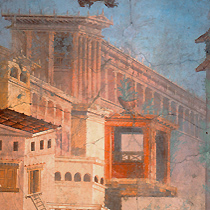 1>
1>Perspective and Mirroring
The visual syntax that gave the Second Style its often overwhelming sense of virtual reality, was based on a subtle interplay between naturalist and trompe l’oeil compositions, at the heart of which lay a sophisticated understanding of linear and atmospheric perspective.
Although the artists who produced these compositions may not have fully understood the geometric and mathematical laws governing perspective they were, never-the-less, able to manipulate, at a very sophisticated level, the spatial and atmospheric repertoire associated with it (fig.1&2). By its very nature linear perspective has a centralising effect, because it unites the pictorial vanishing point with the viewers point of site and thus the viewer and that which is viewed become synonymous. This principle is magnified when all four walls of a room contain perspectival compositions. In this instance synonymity gives way to total immersion and the inhabitants are then quite literally living within a painting.
A new feature unique to Roman wall-painting emerged along with the increased use of architectural compositions. For some reason, which still remains unclear, entire wall-paintings were mirrored on opposing walls. The compositions remained virtually the same except for a few emblematic or symbolic differences (fig.3). From a formal point of view mirroring placed the viewer between entrances to two apparently identical metaphysical worlds, separated only by the physical space of the room. The conceptual implications of this are discussed in "Wall-Painting and the House as Sanctuary".
If we accept that the mythological paintings framed by trompe l’oeil architecture were derived from pattern books containing illustrations of earlier panel paintings or were created by direct visualisations of mythic narratives, it prompts the question; are the surrounding architectonic compositions also derived from pattern books or are they based on actual architectural sources? The architectural environments that emerged with the Second Style are sometimes so immersive that they make the physical proportions of the room disappear, unlike the architectonic references in the Third and Fourth Styles, which are primarily fictionalized. The fact that the architectural depiction is coherently applied throughout the room tends to imply that the entire composition is not derived from a pattern book, but that does not exclude the possibility that individual architectural elements may well have been taken from such a source. In addition, there appears to be no direct referencing of buildings in Pompeii or Herculaneum. In Funerary Symbolism in Apulian Vase-Painting the author attempted to locate specific monuments that may have acted as models for funerary architecture depicted in Italiote vase-paintings, but without success. (Smith 1976: 220) The same uncertainty arises with the many vignettes depicting houses, villas, temples and tombs, which may represent actual or imagined buildings (fig.4).
|